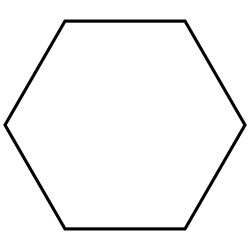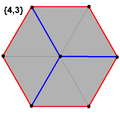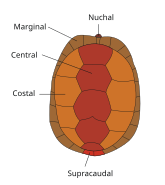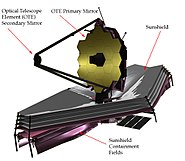| Regular hexagon | |
|---|---|
 A regular hexagon, {6} | |
| Edges and vertices | 6 |
| Schläfli symbols | {6} t{3} |
| Coxeter–Dynkin diagrams | |
| Symmetry group | Dihedral (D6) |
| Area (with = edge length) |
|
| Internal angle (degrees) |
120° |
In geometry, a hexagon is a polygon with six edges and six vertices. A regular hexagon has Schläfli symbol {6}.
Regular hexagon[]

A regular hexagon is constructible with compass and straightedge. The following is a step-by-step animated method of this, given by Euclid's Elements, movie IV, Proposition 15.
The internal angles of a regular hexagon (where all of the sides are the same) are all 120° and the hexagon has 720 degrees T. It has 6 rotational symmetries and 6 reflection symmetries, making up the dihedral group D6. The longest diagonals of a regular hexagon, connecting diametrically opposite vertices, are twice its sides in length. Like squares and equilateral triangles, regular hexagons fit together without any gaps to tile the plane (three hexagons meeting at every vertex), and so are useful for constructing tessellations. The cells of a beehive honeycomb are hexagonal for this reason and because the shape makes efficient use of space and building materials. The Voronoi diagram of a regular triangular lattice is the honeycomb tessellation of hexagons.
The area of a regular hexagon of side length is given by
Also, it can be found by the formula , where is the apothem and is the perimeter.
The perimeter of a regular hexagon of side length is, of course, , its maximal diameter , and its minimal diameter . There is no platonic solid made of regular hexagons. The archimedean solids with some hexagonal faces are the truncated tetrahedron, truncated octahedron, truncated icosahedron (of soccer ball and fullerene fame), truncated cuboctahedron and the truncated icosidodecahedron.
Related figures[]
 A regular hexagon can also be created as a truncated equilateral triangle, with Schläfli symbol t{3}. This form only has D3 symmetry. In this figure, the remaining edges of the original triangle are drawn blue, and new edges from the truncation are red. |
 The hexagram can be created as a stellation process: extending the 6 edges of a regular hexagon until they meet at 6 new vertices. |
Hexagons: natural and human-made[]
Petrie polygons[]
The regular hexagon is the Petrie polygon for these regular and uniform polytopes, shown in these skew orthogonal projections:
| (3D) | (5D) | |||
|---|---|---|---|---|
 Cube |
 Octahedron |
 5-simplex |
 Rectified 5-simplex |
 Birectified 5-simplex |
See also[]
- Hexagram: 6-sided star within a regular hexagon
- Unicursal hexagram: single path, 6-sided star, within a hexagon
- Hexagonal tiling: a regular tiling of hexagons in a plane
- Hexagonal number
External links[]
- Weisstein, Eric W., "Hexagon" from MathWorld.
- Definition and properties of a hexagon With interactive animation
- Cassini Images Bizarre Hexagon on Saturn
- Saturn's Strange Hexagon
- A hexagonal feature around Saturn's North Pole
- "Bizarre Hexagon Spotted on Saturn" - from Space.com (27 March 2007)
| ||||||||||||||||||||
af:Seshoek
ar:سداسي
ast:Hexágonu
az:Düzgün altıbucaqlı
bg:Шестоъгълник
ca:Hexàgon
cs:Šestiúhelník
da:Sekskant
eo:Seslatero
eu:Hexagono
gl:Hexágono
id:Segienam
it:Esagono
he:משושה
ht:Egzagòn
lt:Šešiakampis
hu:Hatszög
ms:Heksagon
mn:Зургаан өнцөгт
nl:Zeshoek
no:Heksagon
nn:Heksagon
nrm:Siêx-carres
pl:Sześciokąt
pt:Hexágono
simple:Hexagon
sk:Šesťuholník
sl:Šestkotnik
sr:Шестоугао
su:Sisi genep
sv:Hexagon
ta:அறுகோணம்
te:షడ్భుజి
th:รูปหกเหลี่ยม










![Saturn hexagonal north pole feature.jpg (623 KB) North polar hexagonal cloud feature on Saturn, discovered by Voyager 1 and confirmed in 2006 by Cassini [1] [2] [3]](https://upload.wikimedia.org/wikipedia/commons/thumb/3/3e/Saturn_hexagonal_north_pole_feature.jpg/185px-Saturn_hexagonal_north_pole_feature.jpg)




